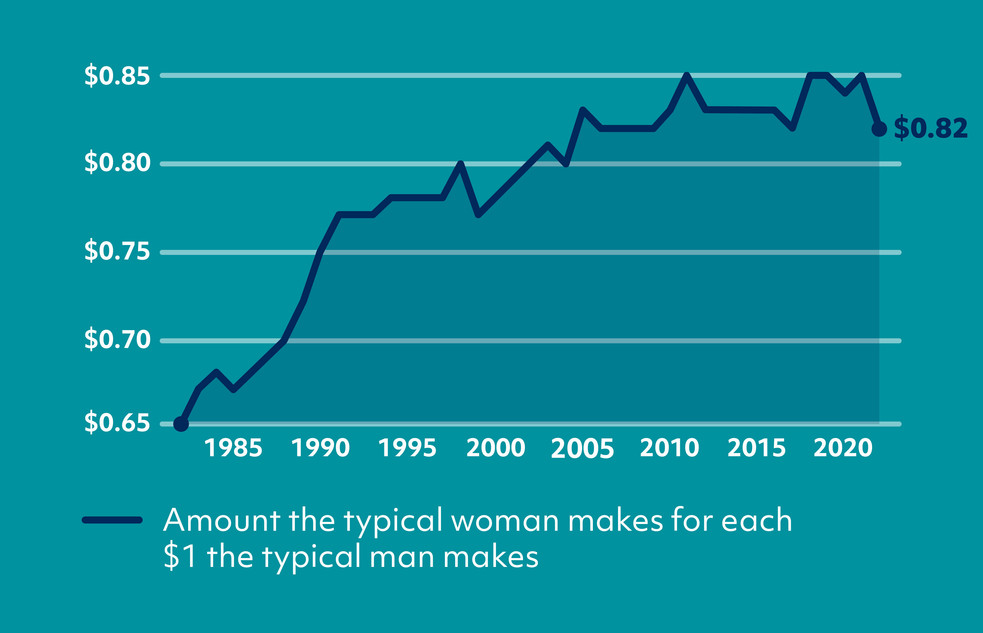
Join the Community Builders Challenge, a NEW hands-on SEL learning experience that combines creativity and compassion to inspire students across the country to build a better world.
Learn MoreA lower salary makes it tougher for women to acheive economic mobility and traps many in a cycle of poverty.
This year, the world marks Equal Pay Day on March 14.
You would think that equal pay for equal work is such an obvious concept that it doesn’t need a day on the calendar to remind us that women still don’t make as much as men. But here we are.
Today — March 14 — is the day when a woman who’s been working full time since the beginning of last year has caught up in earnings to what a man was paid through the end of last year. And it takes even longer if you’re a woman of color, an older woman, or a single mother. Add seasonal workers to the mix, and it’s clear this an issue that demands that we ask: What can we do to fix it?
Right now, a white woman makes 82 percent of the total that a man receives for performing the same work. Part-time and seasonal workers receive 77 percent. Women of color working full time are paid 67 percent for every dollar paid to white men.
A new analysis from Pew Research shows that earlier progress has stalled. From 1985-2002, women’s average pay rose from 65 cents to 80 cents compared to a man’s dollar. In the 20 years since then, that average had risen just 2 cents, with women in 2022 making 82 cents for every dollar made by men, Pew found.
Recent data from the Labor Department highlighted some good news. While women were hit hardest with job losses during the pandemic, employment among women ages 25-54 is back to 100 percent of pre-pandemic levels.
But, even with post-pandemic gains that have brought many women’s earnings back to where they were before COVID struck, women are not caught up.
Experts say that occupational segregation is an issue: Women are over-represented in education, health care, personal care, and services jobs, occupations that pay lower than average wages. Black women are also disproportionately represented in the category of full-time minimum-wage workers. Women in tech and other male-dominated industries including manufacturing and construction often perform different jobs than men and can only advance to management when men holding positions the women will take are themselves promoted.
Older female workers are heavily impacted: Women aged 55-64 earn 22 percent less than men, and women aged 65 and older make 27 percent less than men of the same age. And single mothers suffer the worst of all: they bring in 54 cents for every dollar married men earn.
This continued inequality has profound and long-lasting effects across society – strikingly making economic mobility extremely difficult and trapping many in a cycle of poverty.
A lower salary makes it tougher for women to get a mortgage, and real estate ownership is critical to accumulating generational wealth. Lower lifetime earnings also harm women in later life. Social Security provides more than half of family income to 52 percent of the elderly and at least 90 percent of income to 25 percent of the elderly, but women receive only 80 percent of the benefits men receive. Benefits are based on a person’s 35 highest earning years.
Lower lifetime earnings also reduce the wealth women can accumulate from employer-sponsored retirement plans, which depend on salary, tenure, and contributions.
Comic Relief US is committed to raising both awareness of this inequality and working to bring real and lasting change to these pay equity issues. It’s why we invest in programs that offer access to early education and STEAM learning from pre-k through college. It’s why we partner with organizations that empower girls and young women, creating economic mobility through job training, entrepreneurial mentorship, and leadership development.
Paying workers fairly means more women can support their families and contribute to the economy. True pay equity requires us to effectively address injustices of both gender and race that women encounter every day, which will create a better society for everyone.




.JPG)
.jpg)